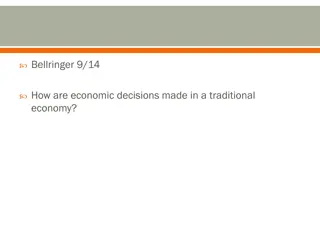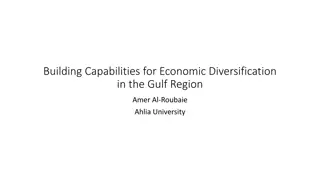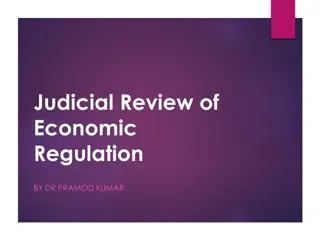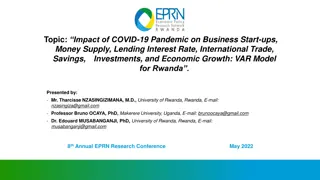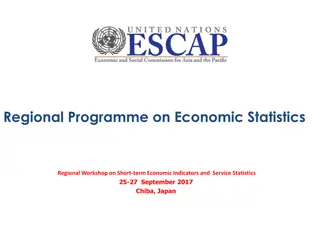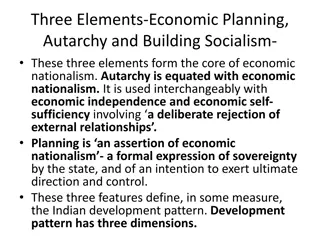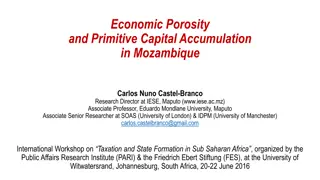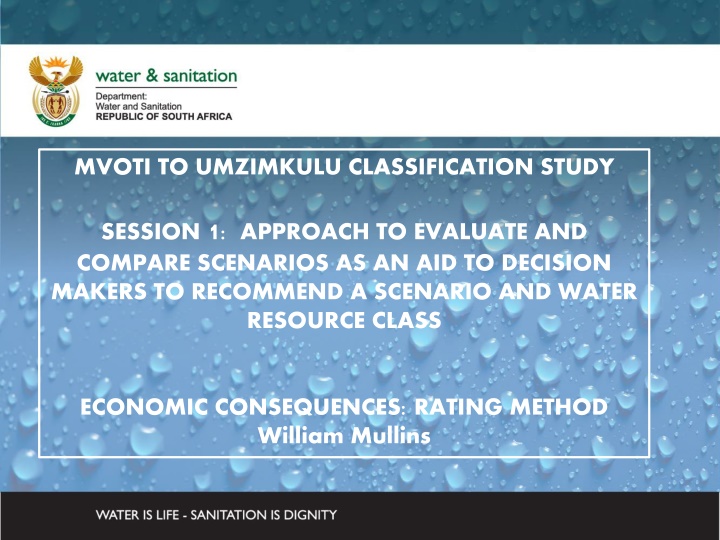
Economic Evaluation and Multipliers in Decision Making
Explore the economic evaluation in the public sector, including metrics like GDP and employment, and learn how multipliers impact decision-making by magnifying economic effects. Discover the significance of comparative statics in analyzing scenarios for better decision-making.
Download Presentation

Please find below an Image/Link to download the presentation.
The content on the website is provided AS IS for your information and personal use only. It may not be sold, licensed, or shared on other websites without obtaining consent from the author. If you encounter any issues during the download, it is possible that the publisher has removed the file from their server.
You are allowed to download the files provided on this website for personal or commercial use, subject to the condition that they are used lawfully. All files are the property of their respective owners.
The content on the website is provided AS IS for your information and personal use only. It may not be sold, licensed, or shared on other websites without obtaining consent from the author.
E N D
Presentation Transcript
MVOTI TO UMZIMKULU CLASSIFICATION STUDY DWA CORPORATE IDENTITY Presented by: Johan Maree Deputy Director: Media Production COMPARE SCENARIOS AS AN AID TO DECISION MAKERS TO RECOMMEND A SCENARIO AND WATER RESOURCE CLASS SESSION 1: APPROACH TO EVALUATE AND 12 December 2012 ECONOMIC CONSEQUENCES: RATING METHOD William Mullins
Economic evaluation in the public sector Attributes Public Sector Private Sector Perspective The broader community Project shareholders/Capital providers Goal Most effective application of scarce resources Maximization of net value Scope All aspects necessary for a rational economic decision Limited to aspect that affect profits Benefits Additional goods, services, income and cost saving Profit and financial return on capital employed Costs Opportunity costs of goods and services foregone Financial payments and depreciation calculate according to generally accepted accounting principles 2
Metrics used in evaluation Gross Domestic Product (GPD): Used to measure the economic output of a region as well as relative contribution of an industrial sector. It then follows that GDP is used to indicate the change in economic growth on a specific sector. Growth size is dependent on multiplier effect. Employment: This metric indicates the number of additional jobs as a result of a change in water provision. Employment is used to indicate poverty alleviation. Multipliers: The fiscal multiplier effect occurs when an initial injection into the economy causes a bigger final increase in national income 3
Multipliers: What are they and how are they used Econometric multipliers: Suppose a computer has a processor that has a clock frequency of 5GHz. Gigahertz represents 109Hz, thus 5 GHz equals 5 billion Hz. This Giga-prefix acts as a multiplier of 1 billion. The same principle applies in economics where the effect of a change in value can be deduced by using multipliers. The general method for calculating short-run multipliers is called comparative statics. That is, comparative statics calculates how much one or more internal variables change in the short run, given a change in one or more external variables. Our comparative statics in this case is GDP and employment. 4
Effect of multipliers In the economy, there is a circular flow of income and spending. Money that is earned flows from one source to another, and most of it gets spent again, multiple times. What this means is that small increases in spending lead to much larger increases in economic output. Multipliers are then used to measure how much spending gets multiplied. To illustrate this, let's take a look at a very simple economy: 5
Principle behind multipliers Consider a R300 million increase in capital investment, for example, if Toyota invests in a new assembly plant. This will set of a chain of increases and expenditures. Businesses who win contracts to build the new factory will see an increase in income and profits If they and their employees in turn collectively spend about of that additional income, then R150 million will be added to the income of others. At this point, total income has grown by R300m + R150m The sum will continue to increase as producers of additional goods and services realize an increase in their incomes, of which they in turn spend on even more goods and services. This is what is meant by the multiplier effect 6
How are these multipliers obtained Input-Output (I-O) Models: These models characterise the interdependence of sectors within an economy by generating data on multipliers and leakages. Multipliers show that the impact of a particular sector on the regional/national economy (in terms of some of the above criteria) is larger than the value/volume associated solely with that sector s output. Leakages indicate where economic impacts, such as project revenues, move ("leak ) from one region or economy to another. Social Accounting Matrices (SAMs): SAMs use a mathematically based matrix presentation to represent the flow of funds linked to demand, production and income within a national or regional economy. SAMs can be designed with a special emphasis on social rather than economic attributes (e.g. low income households) and, thereby, also provide information about equity and distribution issues. SAMs can be regarded as an extension of I-O models. 7
Methodology based on CBA principles Status quo Volume of water Status quo Value of water in GDP Growth on status quo Apply value of water on growth volume Status quo Employment Discount according to CBA principles Apply employment on growth volume Projected GDP growth Projected additional employment 8
Water volumes ( Mm3/a) Mvoti Isithundu Excess Firm Yield MV3 34.88 MV41 8.08 MV42 15.22 MV43 13.77 Umkhomazi Scenarios Smithfield HFY (No support to Ngwadini) Ngwadini HFY (No sup from Smithfield) No EWR With EWR No EWR With EWR MK1 MK2 196.0 11.99 MK21 142.20 8.03 MK22 150.60 8.03 MK23 150.60 8.03 MK31 150.10 5.98 MK32 161.00 6.63 MK33 161.00 6.63 Smithfield HFY (With support to Ngwadini) Ngwadini HFY (With support from Smithfield) Mkomazi multiplier MK4 142.5 54.80 MK41 84.10 54.80 MK42 92.50 54.80 9
Capital costs Capital costs used in scenarios: River Cost estimate (2009 R million) Cost estimate (2013 R million) Escalation factor applied for 2009 to 2013 prices Mvoti 1 261 1 645 1.30 Umkhomazi 2 604 3 412 1.31 10
Operation and Maintenance Annual operation and maintenance costs are based on the following percentages of capital costs: 0,5% of the pipeline capital cost 4% of the electrical and mechanical installation of a pump station 0,25% of the capital cost civil structures including the civil portion of pump stations These costs are based on the escalated capital costs. 11
Growth rates Growth rates and water demand Urban water demand 5%: This is as a result of population growth and a higher utilization of water as wealth increases Industrial water demand 6%: This rate is in line with the real economic growth as foreseen in the National Development Plan. 12
Benefits in Mvoti 1. Urban: Households and total municipal water use 2. Industry: Sugar factories, saw mills etc. 3. Irrigation: Vegetables, sugarcane etc. 4. Forestry: No change Benefits Year 7 Year 8 Year 9 Year 10 Year 11 Year 12 Growth rate industrial 6.00% 6.36% 6.74% 7.15% 7.57% 8.03% Growth rate domestic 1.50% 1.52% 1.55% 1.57% 1.59% 1.62% Growth rate irrigation 10.00% 11.00% 12.10% 13.31% 14.64% 16.11% Growth volume industrial 2.03 2.15 2.28 2.41 2.56 2.71 Growth volume domestic 0.22 0.23 0.23 0.23 0.24 0.24 Growth volume irrigation 4.01 4.01 4.01 4.01 4.01 4.01 Turnover industrial R 1 680.99 R 1 781.85 R 1 888.76 R 2 002.08 R 2 122.21 R 2 249.54 Turnover domestic R 2.71 R 2.75 R 2.79 R 2.83 R 2.87 R 2.92 Turnover irrigation R 52.86 R 52.86 R 52.86 R 52.86 R 52.86 R 52.86 Total turnover R 1 736.56 R 1 837.45 R 1 944.41 R 2 057.77 R 2 177.94 R 2 305.32 13
Benefits - Mkomazi and Transfer 1. Urban: Households and total municipal water use 2. Industry: Saiccor and transfer 3. Irrigation Small increase in catchment Benefits Year 7 Year 8 Year 9 Year 10 Year 11 Year 12 Growth rate Saiccor 6.00% 6.36% 6.74% 7.15% 7.57% 8.03% Growth rate industrial 6.00% 6.36% 6.74% 7.15% 7.57% 8.03% Growth rate domestic 5.00% 5.25% 5.51% 5.79% 6.08% 6.38% Growth rate irrigation 10.00% 11.00% 12.10% 13.31% 14.64% 16.11% Growth volume Saiccor 3.36 3.56 3.77 4.00 4.24 4.50 Growth volume industrial 6.60 7.00 7.42 7.86 8.33 8.83 Growth volume domestic 9.50 9.98 10.47 11.00 11.55 12.12 Growth volumeirrigation 0.00 0.00 0.00 0.00 0.00 0.00 Turnover Saiccor R 2 785.43 R 2 952.56 R 3 129.71 R 3 317.49 R 3 516.54 R 3 727.53 Turnover industrial R 15 094.56 R 16 000.23 R 16 960.24 R 17 977.86 R 19 056.53 R 20 199.92 Turnover domestic R 115.35 R 121.12 R 127.18 R 133.54 R 140.21 R 147.22 Turnover irrigation R - R - R - R - R - R - Total Benefits R 17 995.34 R 19 073.91 R 20 217.13 R 21 428.89 R 22 713.28 R 24 074.68 14
Results Mvoti scenarios Scenario Projected GDP growth (R million) Projected additional labour Rank MV3 28 137 17 052 1 MV41 16 208 6 619 4 MV42 22 737 10 821 2 MV43 21 838 10 091 3 15
Results Umkhomazi scenarios Scenario Projected GDP growth (R million) Projected additional labour GDP growth rank Additional labour rank MK2 307 088 275 738 1 1 MK21 297 608 260 313 4 6 MK22 298 911 264 275 3 3 MK23 298 911 264 275 3 3 MK31 294 227 263 219 6 4 MK32 297 235 267 677 5 2 MK33 297 235 267 677 5 2 MK4 302 756 261 709 2 5 MK41 281 671 210 773 8 8 MK42 282 626 221 116 7 7 16




